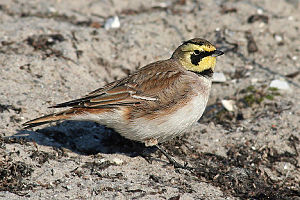Ear lark
| Ear lark | ||||||||||||
|---|---|---|---|---|---|---|---|---|---|---|---|---|

Ear lark ( Eremophila alpestris ) |
||||||||||||
| Systematics | ||||||||||||
|
||||||||||||
| Scientific name | ||||||||||||
| Eremophila alpestris | ||||||||||||
| ( Linnaeus , 1758) |
The ear lark ( Eremophila alpestris ) is unmistakable in summer thanks to a face mask and "devil horns", which are shorter in females. The body length of this species of lark is between 16 and 17 cm. The ear lark is almost as skilled on foot as it is in the air.
The range of the ear lark is very large. As a breeding bird widespread in the Holarctic, the species occurs from the Atlas Mountains of Morocco to North and South America. She is a regular winter visitor to the coasts of Central Europe.
habitat
The ear lark prefers areas with no trees or shrubbery; it is found in southern areas above the tree line and in the northern lichen tundra as well as in the North American Great Plains . In North Dakota, for example, it is considered the most common breeding bird. Sometimes they can also be found on the banks of lakes or on the coast.
In the southern distribution areas, the ear lark is usually a resident bird , while northern populations migrate south in winter, preferably to coastal areas. While they are often very shy in the breeding area, winter guests often show more familiar behavior.
Distribution and subspecies
The lark breeds in northern Europe, in the mountains of southeastern Europe, in northwestern Africa, in Asia and in North America from high arctic regions to the isthmus of Tehuantepec . There is also an isolated subspecies, E.a. peregrina , in the highlands of Colombia , which is the only lark in South America.
Up to 40 subspecies are distinguished from the ear lark. The nominate form, E. a. alpestris , breeds in an area stretching south from the southeastern Baffin Island to the northern Labrador Peninsula . The northern European subspecies is E. a. flava , which occurs in all of northern Asia up to the Bering Strait . The transition between the individual subspecies is gradual in terms of appearance.
Reproduction
Ear larks reach sexual maturity in their first year of life. They enter into a monogamous seasonal marriage. The nest is usually well hidden under a bush in a well-insulated hollow. The breeding season is from June to July. During this time, 4 eggs are usually incubated for 10 to 14 days. Only the female parent bird breeds. The nestling duration is 9 to 12 days. The female herds the nestlings for the first five days, but they are fed by both parent birds.
food
Insects and seeds are on the menu .
Tribal history
A frozen carcass of a lark was reported in the permafrost area of Yakutia in North Asia in 2020. This comes from the banks of the Tirechtjach, which is part of the Indigirka catchment area . According to radiometric dating , the individual is around 42,600 years old.
supporting documents
literature
- Hans-Günther Bauer, Einhard Bezzel and Wolfgang Fiedler (eds.): The compendium of birds in Central Europe: Everything about biology, endangerment and protection. Volume 2: Passeriformes - passerine birds. Aula-Verlag Wiebelsheim, Wiesbaden 2005, ISBN 3-89104-648-0 .
Single receipts
- ^ Paul A. Johnsgard: Great Wildlife of the Great Plains . University Press of Kansas, 2003, ISBN 0-7006-1224-6 , pp. 84-85
- ↑ Bauer et al., P. 144
- ↑ Nicolas Dussex, David WG Stanton, Hanna Sigeman, Per GP Ericson, Jacquelyn Gill, Daniel C. Fisher, Albert V. Protopopov, Victoria L. Herridge, Valery Plotnikov, Bengt Hansson and Love Dalén: Biomolecular analyzes reveal the age, sex and species identity of a near-intact Pleistocene bird carcass. Communications Biology 3, 2020, p. 84, doi: 10.1038 / s42003-020-0806-7
Web links
- Eremophila alpestris inthe IUCN Red List of Threatened Species 2016.1. Posted by: BirdLife International, 2017. Retrieved January 1, 2017.
- Videos, photos and sound recordings on Eremophila alpestris in the Internet Bird Collection
- Feathers of the ear lark
